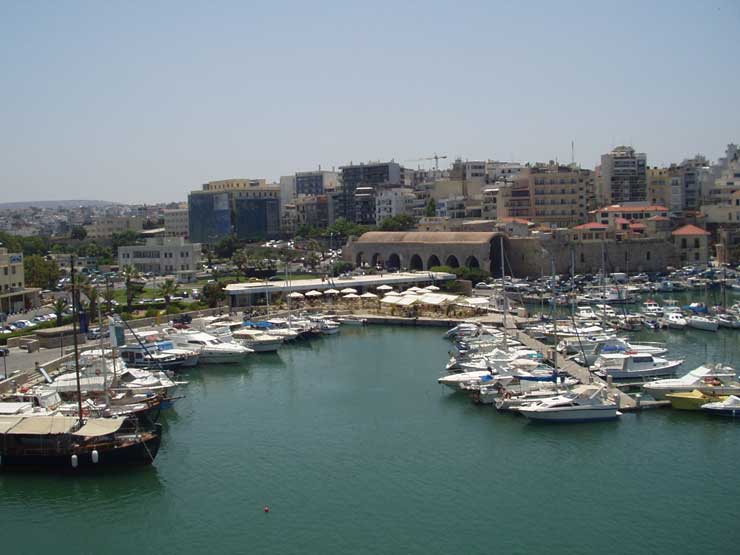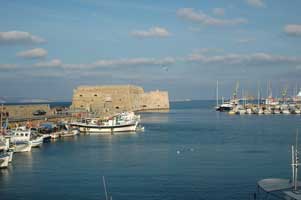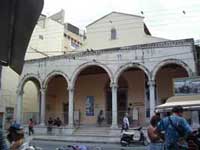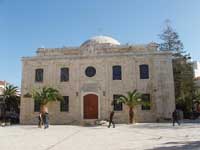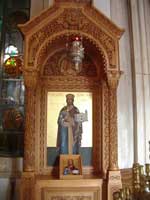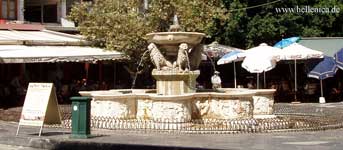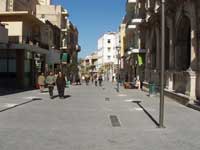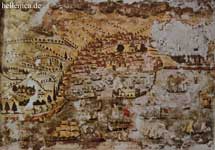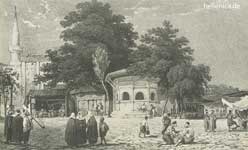.
Administrative Region : Crete
Regional unit : Heraklion
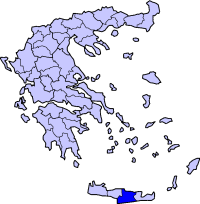
|
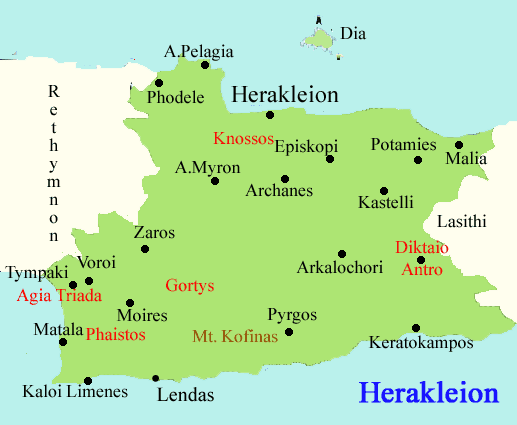 |
Heraklion, or Heraclion (Greek: Ηράκλειο Greek pronunciation: [iˈraklio]) is the largest city and the administrative capital of the island of Crete, Greece. It is the 4th largest city in Greece.
Heraklion is the capital of Heraklion peripheral unit. The ruins of Knossos, which were excavated and restored by Arthur Evans, are nearby. The Heraklion International Airport is named after Nikos Kazantzakis.
Name
The Andalusian raiders who founded the Emirate of Crete moved the island's capital from Gortyna to what a new castle they called rabḍ al-ḫandaq 'Castle of the Moat' in the 820s.[1] This was hellenized as Χάνδαξ (Handax) or Χάνδακας and Latinized as Candia, which was taken into other European languages: French Candie, English Candy, all of which could refer to all of Crete as well as to the city itself; the Ottoman form was Kandiye.
After the Byzantine reconquest, the city was locally known as Megalo Kastro or Castro (the Big Castle in Greek) and its inhabitants were called Kastrinoi or Castrini (Castle-dwellers in Greek).
The pagan name Ηράκλειον was revived in the 19th century[2] and comes from the nearby Roman port of Heracleum ("Heracles' city"), whose exact location is unknown. English usage formerly preferred the classicizing transliterations "Heraklion" or "Heraclion", but the form "Iraklion" is becoming more common.
History
The snake goddess (c.1600 BCE) in Heraklion Archaeological Museum.
Heraklion is close to the ruins of the palace of Knossos, which in Minoan times was the largest centre of population on Crete. Though there is no archaeological evidence of it, Knossos may well have had a port at the site of Heraklion as long ago as 2000 BC.
Founding
The present city of Heraklion was founded in 824 AD by the Saracens who had been expelled from Al-Andalus by Emir Al-Hakam I and had taken over the island from the Eastern Roman Empire. They built a moat around the city for protection, and named the city ربض الخندق, rabḍ al-ḫandaq ("Castle of the Moat"). The Saracens allowed the port to be used as a safe haven for pirates who operated against Imperial shipping and raided Imperial territory around the Aegean.
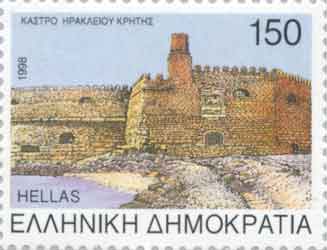
Restored Greek Era
Further information: Byzantine Greece
In 961 Imperial forces under the command of Nikephoros Phokas, later to become Emperor, landed in Crete and attacked the city. After a prolonged siege, the city fell. The Saracen inhabitants were slaughtered, the city looted and burned to the ground. Soon rebuilt, the town of Chandax remained under Greek control for the next 243 years.
Venetian control
The Venetian loggia (1626–28).
Α part of the Venetian walls.
Further information: Republic of Venice
In 1204, the city was bought by the Republic of Venice as part of a complicated political deal which involved among other things, the Crusaders of the Fourth Crusade restoring the deposed Eastern Roman Emperor Isaac II Angelus to his throne. The Venetians improved on the ditch of the city by building enormous fortifications, most of which are still in place, including a giant wall, in places up to 40 m thick, with 7 bastions, and a fortress in the harbour. Chandax was renamed Candia and became the seat of the Duke of Candia, and the Venetian administrative district of Crete became known as "regno di Candia" (kingdom of Candia). The city retained the name of Candia for centuries and the same name was often used to refer to the whole island of Crete as well. To secure their rule, Venetians began in 1212 to settle families from Venice on Crete. The coexistence of two different cultures and the stimulus of Italian Renaissance led to a flourishing of letters and the arts in Candia and Crete in general, that is today known as the Cretan Renaissance.
Ottoman Era
The Ottoman Vezir Mosque (1856), built on the site of the church of St Titus, and now the basilica of St Titus.
After the Venetians came the Ottoman Empire. During the Cretan War (1645–1669), the Ottomans besieged the city for 21 years, from 1648 to 1669, perhaps the longest siege in history. In its final phase, which lasted for 22 months, 70,000 Turks, 38,000 Cretans and slaves and 29,088 of the city's Christian defenders perished.[3] The Ottoman army under an Albanian grand vizier, Köprülü Fazıl Ahmed Pasha conquered the city in 1669. Under the Ottomans, the city was known officially as Kandiye (again also applied to the whole island of Crete) but informally in Greek as Megalo Castro (Μεγάλο Κάστρο; "Big Castle"). During the Ottoman period, the harbour silted up, so most shipping shifted to Chania in the west of the island.
Modern era
The Cathedral.
An outdoor market in Heraklion.
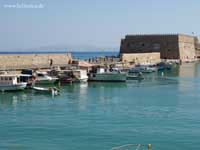
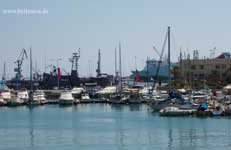
In 1898 the autonomous Cretan State was created, under Ottoman suzerainty, with Prince George of Greece as its High Commissioner and under international supervision. During the period of direct occupation of the island by the Great Powers (1898–1908), Candia was part of the British zone. At this time the city was renamed "Heraklion", after the Roman port of Heracleum ("Heracles' city"), whose exact location is unknown.
In 1913 with the rest of Crete Heraklion was incorporated into the Kingdom of Greece.
Municipality
The municipality Heraklion was formed at the 2011 local government reform by the merger of the following 5 former municipalities, that became municipal units:[4]
Gorgolainis
Heraklion
Nea Alikarnassos
Paliani
Temenos
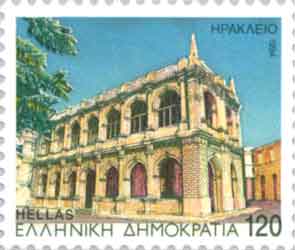
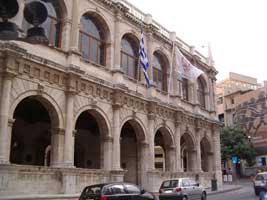
Archaeological Museum of Heraklion
Transportation
A street of Heraklion.
Port
Heraklion is an important shipping port and ferry dock. Travellers can take ferries and boats from Heraklion to a multitude of destinations including Santorini, Ios Island, Paros, Mykonos, and Rhodes. There are also several daily ferries to Piraeus, the port of Athens on mainland Greece.
Airport
Heraklion International Airport, or Nikos Kazantzakis Airport is located about 5 km east of the city. The airport is named after Heraklion native Nikos Kazantzakis, a writer and philosopher. It is the second busiest airport of Greece, due to Crete being a major holiday destination.
There are regular domestic flights to and from Athens, Thessaloniki and Rhodes with Aegean Airlines and Olympic Air. Athens Airways also offers flights to and from Athens. Cyprus Airways and Aegean Airlines fly to and from Larnaca, in Cyprus. Furthermore, Sky Express operates direct flights to Aegean islands such as Rhodes, Santorini, Samos, Kos, Mytilini, and Ikaria.
Aegean Airlines has an international schedule to and from London and Paris and EasyJet flys direct from London Gatwick. During the summer, the number of scheduled and chartered flights increase as do the number of airlines that fly direct from all over Europe (mostly Germany, UK, Italy, and Russia).
The airfield is shared with the 126 Combat Group of the Hellenic Air Force.
Highway Network
European route E75 runs through the city and connects Heraklion with the three other major cities of Crete: Agios Nikolaos, Chania, and Rethymno.
Public transit
There are a number of buses serving the city and connecting it to many major destinations in Crete.
Panoramic view of the harbour.
Climate
Crete has a warm Mediterranean climate. Summers in the lowlands are hot and dry with clear skies. Dry hot days are often relieved by seasonal breezes. The mountain areas are much cooler, with considerable rain in the winter. Winters are mild in the lowlands with rare frost and snow. Because Heraklion is further south than Athens, it has a milder climate.
| ]Climate data for Heraklion | |||||||||||||
|---|---|---|---|---|---|---|---|---|---|---|---|---|---|
| Month | Jan | Feb | Mar | Apr | May | Jun | Jul | Aug | Sep | Oct | Nov | Dec | Year |
| Average high °C (°F) | 15.2 (59.4) |
15.5 (59.9) |
16.8 (62.2) |
20.2 (68.4) |
23.5 (74.3) |
27.3 (81.1) |
28.6 (83.5) |
28.4 (83.1) |
26.4 (79.5) |
23.1 (73.6) |
20.1 (68.2) |
17.0 (62.6) |
21.9 (71.4) |
| Daily mean °C (°F) | 12.1 (53.8) |
12.3 (54.1) |
13.3 (55.9) |
16.1 (61.0) |
19.2 (66.6) |
23.2 (73.8) |
25.2 (77.4) |
25.1 (77.2) |
22.9 (73.2) |
19.8 (67.6) |
16.8 (62.2) |
14.0 (57.2) |
18.4 (65.1) |
| Average low °C (°F) | 9.0 (48.2) |
9.0 (48.2) |
9.8 (49.6) |
12.0 (53.6) |
14.9 (58.8) |
19.0 (66.2) |
21.7 (71.1) |
21.7 (71.1) |
19.3 (66.7) |
16.5 (61.7) |
13.4 (56.1) |
10.9 (51.6) |
14.8 (58.6) |
| Precipitation mm (inches) | 91.5 (3.602) |
77.4 (3.047) |
57.4 (2.26) |
30.0 (1.181) |
15.2 (0.598) |
3.2 (0.126) |
1.0 (0.039) |
0.7 (0.028) |
19.5 (0.768) |
68.8 (2.709) |
58.8 (2.315) |
77.1 (3.035) |
500.6 (19.709) |
| Avg. precipitation days | 10.1 | 9.1 | 6.9 | 3.4 | 1.9 | 0.5 | 0.1 | 0.1 | 1.3 | 4.9 | 6.0 | 8.9 | 53.2 |
| Mean monthly sunshine hours | 117.8 | 124.7 | 176.7 | 228.0 | 300.7 | 351.0 | 372.0 | 347.2 | 282.0 | 198.4 | 150.0 | 120.9 | 2,769.4 |
| Source: Hong Kong Observatory[5] | |||||||||||||
Colleges, Universities, and Research Centers
University of Crete
TEI of Crete
Foundation for Research & Technology - Hellas
Culture
The Phaistos disk (2nd millennium BC) in Heraklion Archaeological Museum.
Museums
Heraklion Archaeological Museum
Cretaquarium
Historical Museum of Crete
Natural History Museum
The Battle of Crete and National Resistance Museum
Nikos Kazantzakis Museum
Lychnostatis Open Air Museum
Collection of Agia Aikaterini of Sinai
Museum of Visual Arts
Sports
The city hosts three football clubs:
Ergotelis FC – in Heraklion, plays in the first division.
OFI Crete in Heraklion, plays in the first division.
Atsalenios – Football Club of Heraklion which plays in the third division.
Famous natives
Heraklion has been the home town of some of Greece's most significant spirits, including the novelist Nikos Kazantzakis, the poet and Nobel Prize winner Odysseas Elytis and the world-famous painter Domenicos Theotokopoulos (El Greco).
Literature
Epitaph on Nikos Kazantzakis' grave. I don't hope for anything, I don't fear anything, I'm free.
Elli Alexiou (1894–1988) author
Aris Diktaios, poet and translator
Minás Dimákis (1913–1980) poet
Odysseas Elytis (1911–1996) Nobel awarded poet
Tess Fragoulis, Greek-Canadian author
Rea Galanaki (1947–present) author
Galatea Kazantzaki author
Nikos Kazantzakis (1883–1957) author
Pedro de Candia, (1485–1542) author and travel writer, recorded the Spanish Conquest of the Americas
Ioannis Kondylakis (1862–1920) author
Vitsentzos Kornaros (1553–1613) author
Stephanos Sahlikis (1330-after 1391) poet
Lili Zografou (1922–1998) author
Scientists and Scholars
Marcus Musurus (left) and Nicholas Kalliakis (right) were two significant Renaissance humanists, scholars and philosophers from Heraklion.[6]
Nicholas Kalliakis (1645–1707)- Greek Cretan scholar and philosopher[7]
Andreas Musalus (ca. 1665 – 1721) Greek Cretan professor of Mathematics, Philosopher and Architectural theorist[8]
Francesco Barozzi (1537–1604) mathematician and astronomer
Manolis Hatzidakis, archaeologist
Fotis Kafatos biologist, President of the European Research Council
Maximos Margunios (1549–1602) scholar, theologian, poet and writer, titular bishop of Kythira
Marcus Musurus (Markos Mousouros) (1470–1517) scholar and philosopher
Nikolaos Panagiotakis (1935–1997) byzantinologist
Peter of Candia also known as Antipope Alexander V, philosopher and scholar.
Joseph Sifakis (1946–present) computer scientist, co-recipient of the 2007 Turing Award
Gerasimos Vlachos (1607–1685), scholar
Simone Stratigo (ca. 1733 – 1824), Greek mathematician and an Nautical science expert, whose family was from Heraklion (Candia), Crete.[9]
Painting
El Greco (Dominikos Theotokopoulos).
Theophanes (ca.1500–1559) painter of icons
Michael Damaskinos (1530/35-1592/93) painter of icons
El Greco (1541–1614) mannerist painter, sculpturer and architect
Georgios Klontzas (1540–1607) painter of icons
Theodoros Poulakis (1622–1692) painter of icons
Andreas Ritzos (1422–1492) painter of icons
Emmanuel Tzanes (1610–1690) painter of icons
Aristidis Vlassis (*1955) painter
Konstantinos Volanakis (1837–1907) painter
Film industry
Giorgos Anemogiannis, scenographer
Rika Diallina (1934), actress and model, Miss Hellas
Ilya Livykou (1919–2002), actress
Sapfo Notara (1907–1985), actress
Aleka Paizi, actress
Yannis Smaragdis (1946), film director
Music
List of radio stations in Greece Greek music from Crete – heraklion live on the net
Rena Kyriakou (1918–1994) pianist
Fragiskos Leontaritis (Francesco Londarit) (1518–1572) composer
Christos Leontis (1940) composer
Giannis Markopoulos (1939) composer
Manolis Rasoulis (1945) lyrics writer
Notis Sfakianakis (1959) singer
Sports
Nikos Machlas (1973) footballer
Georgios Samaras (1985) footballer
Business
Constantine Corniaktos (1517–1603) wine merchant and wealthiest man in the Eastern European city of Lviv.[10]
Gianna Angelopoulos-Daskalaki (1955) business woman and politician
Politics
Leonidas Kyrkos, politician
Aristidis Stergiadis (1861–1950) High Commissioner of Smyrna
Georgios Voulgarakis (1959) conservative politician
Law
Romilos Kedikoglou (1940) President of the Court of Cassation of Greece
Clergy
Maximos Margunios (1549–1602), bishop of Cyrigo (Kythira)
Kyrillos Loukaris (1572–1637) theologian, Patriarch of Alexandria as Cyril III and Ecumenical Patriarch of Constantinople as Cyril I
Meletius Pegas, Patriarch of Alexandria
Theodore II (1954) Patriarch of Alexandria
Peter Phillarges (ca. 1339–1410) (also Pietro Di Candia, later Pope Alexander V)
Fashion
Maria Spiridaki (1984) fashion model and television presenter
Local TV stations
Channel 4
Creta Channel
Kriti TV
MyTV
International relations
See also: List of twin towns and sister cities in Greece
Twin towns — sister cities
Heraklion is twinned with:
Romania Constanţa, Romania
Bulgaria Pernik, Bulgaria
See also
Centre for Technological Research of Crete
European Network and Information Security Agency
Foundation for Research & Technology - Hellas
Handakos Street
Lions Square
Minoan civilization
Siege of Candia (1648–1669)
TEI of Crete
University of Crete
References
^ Encyclopaedia of Islam, s.v. Iķrīṭish
^ it was in use by the local people by 1867, see Samuel Gridley Howe, The Cretan refugees and their American helpers, 1867 [1]
^ The War for Candia
^ Kallikratis law Greece Ministry of Interior (Greek)
^ "Climatological Information for Iraklion, Greece" – Hong Kong Observatory
^ Lathrop C. Harper (1886). Catalogue / Harper (Lathrop C.) inc., New York, Issue 232. Lathrop C. Harper, Inc. p. 36. OCLC 11558801. "Calliachius (1645–1707) was born on Crete and went to Italy at an early age, where he soon became one of the outstanding teachers of Greek and Latin."
^ Rose, Hugh James; Rose, Henry John; Wright, Thomas (1857). A new general biographical dictionary, Volume 5. T. Fellowes. p. 425. OCLC 309809847. "CALLIACHI, (Nicholas,) a native of Candia, where he was born in 1645. He studied at Rome for ten years, at the end of which time he was made doctor of philosophy and theology. In 1666 he was invited to Venice, to take the chair of professor of the Greek and Latin languages, and of the Aristotelic philosophy; and in 1677 he was appointed professor of belles-lettres at Padua, where he died in 1707. His works on antiquities are valuable, and have been published by the marquis Poloni in the third volume of his Supplement to the Thesaurus Antiquitatum."
^ Convegno internazionale nuove idee e nuova arte nell '700 italiano, Roma, 19-23 maggio 1975. Accademia nazionale dei Lincei. 1977. p. 429. OCLC 4666566. "Nicolò Duodo riuniva alcuni pensatori ai quali Andrea Musalo, oriundo greco, professore di matematica e dilettante di architettura chiariva le nuove idée nella storia dell’arte."
^ Carlo Capra, Franco Della Peruta, Fernando Mazzocca (2002). Napoleone e la repubblica italiana: 1802-1805. Skira. p. 200. ISBN 8884914159 9788884914156. "Simone Stratico, nato a Zara nel 1733 da famiglia originaria di Creta (abbandonata a seguito della conquista turca del 1669)"
^ I︠A︡roslav Dmytrovych Isai︠e︡vych (2006). Voluntary brotherhood: confraternities of laymen in early modern Ukraine. Canadian Institute of Ukrainian Studies Press. p. 47. ISBN 1894865030. "…the Greek merchants Constantine Korniakt and Manolis Arphanes Marinetos are added. This second redaction appeared no earlier than 1589, as wealthy Greeks began to join the confraternity at a later date, once it had expanded its activities. Korniakt was actually the wealthiest man in Lviv: he traded in Eastern, Western, and local goods, collected customs duty on behalf of the king, and owned a number of villages."
Greece :
| Ancient Greece
Science, Technology , Medicine , Warfare, , Biographies , Life , Cities/Places/Maps , Arts , Literature , Philosophy ,Olympics, Mythology , History , Images Medieval Greece / Byzantine Empire Science, Technology, Arts, , Warfare , Literature, Biographies, Icons, History Modern Greece Cities, Islands, Regions, Fauna/Flora ,Biographies , History , Warfare, Science/Technology, Literature, Music , Arts , Film/Actors , Sport , Fashion --- |
Retrieved from "http://en.wikipedia.org/"
All text is available under the terms of the GNU Free Documentation License


